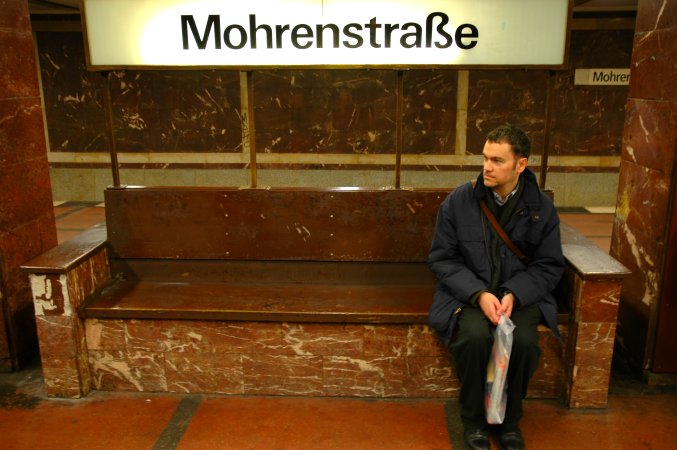
Barry, sitting uneasily
The beautiful red marble which covers the pillars, every wall and even the benches inside the Mohrenstrasse stop on the number 2 U-Bahn has an interesting heritage. It once decorated the walls of Adolf Hitler's lordly Reichskanzlei [Imperial Chancellery], which had stood just a block away. The DDR officials apparently saw no reason to waste resources while rebuilding the transit system after the war.
"Reichskanzlerei" sollte das sein.
actually, we're both wrong. I included an "e" which shouldn't be there [now corrected], and while "Reichskanzlerei" would seem to be the correct spelling, it's actually "Reichskanzlei" according to my Wikipedia.de source
Actually this is only a rumor, which has been proven to be wrong. The same was rumored about the entrance of the HU (East-Berlin university) and two soviet cenotaphs.
André comments that the usual description of the source for the red marble (which may actually be limestone) is an urban legend, and that it has been proven to be wrong.
I haven't been able to find any documentation for such proof on line. I see only references to it being a "rumor" or "urban legend", although the German Wikipedia entry for "Saalburger Marmor" states that geological tests do not support the attribution, with a footnote pointing to a number of pages on the question by art history professor Hans-Ernst Mittig; I've only skimmed them, so I may be wrong, but they appear to be concerned mostly with the social, political and cultural significance of the willingness to believe the more colorful story of the stones' origins.
The only argument which I've found to oppose my understanding of the origin of the stone in the Mohrenstrasse station refers to August, 1950, newspaper articles which appeared at the time the station was being re-built: The East Berlin Neues Deutschland and Berliner Zeitung claimed then that the stone came directly from quarries in Thuringia. Of course it's understandable that the DDR regime would have reason to deny re-using stones so fraught with certain horrible associations.
My question would still be, "Why was this one station, which happens to be located only meters from the Chancellery the Soviet occupiers destroyed only after the war, rebuilt with the elegant decoration of which it now can boast?" Unlike any other U-Bahn station in Berlin, it is lined with some pretty handsome stone, and it is stone which answers the description of that used in Speer's Reichskanzlei.
If anyone has documentation supporting either argument, I'd be anxious to see it.